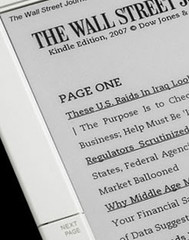
Researchers at MIT Sloan School of Management seem to have found evidence related to something that used to be second nature to advertisers. Touch matters, right down to the details of a business card.
The paper choice, cut, weight: they all matter. Flimsy cards tend to be taken with a little less enthusiasm. The same holds true with most collateral. I once kept a Cirque du Soleil press kit around for several years, simply because the stock felt much more like silk than paper. My firm's first brochure (when we had brochures) considered touch too. Spot varnish across the cover gave life to near invisible words with a tilt and a texture contrast meant to be felt.
Sure, many advertising professionals still know all this, especially those who work with packaging. But there are an increasing number of creatives who don't consider touch. Why would they? For the most part, collateral is falling out of favor for computers. Maybe there is an unseen impact associated with the shift.
What MIT Discovered About Touch.
Through a series of experiments, Joshua Ackerman, an assistant professor of marketing at MIT Sloan (along with John Bargh, a professor of psychology at Yale University; and Christopher Nocera, a PhD candidate at Harvard University), tested how weight, texture and hardness can unconsciously influence judgments. They suggest that their results have implications for anyone and everyone, ranging from job seekers to marketers.
“What we touch unconsciously influences how we think,” says Ackerman. “In situations where evaluations and decisions really matter, we need to pay attention to our physical surroundings and, in particular, how we engage these surroundings through our sense of touch.”
According to their statement, the researchers suggest that interactions involving touch, from handshakes to cheek kisses, may have critical influences on social interactions. First impressions are especially liable, with control over the entire environment becoming important.
• Heavier clipboards influenced evaluators in choosing job candidates. Judged candidates whose resumes were seen on a heavy clipboard were rated as qualified and more serious about the position.
• Rough puzzle pieces tended to describe a story about social interaction as harsh, when compared to participants handling smooth puzzle pieces.
• Participants holding a hard block while hearing a story about a workplace interaction tended to judge the employee as more rigid when compared those who held a soft blanket.
• Subjects seated in hard chairs while haggling over the price of a car tended to be less willing to negotiate than those who sat in softer and more comfortable chairs.
Electronics May Play A Role In How We Process Information.
While it wasn't part of the study, the clipboard experiment seems particularly applicable to an increasingly tech reliant world. After all, there is a growing reliance on communication where marketers have no control over the environment, which could be influencing online interactions.
Does it make a difference whether the computer is set up in a cubicle, noisy living room, or open office with a window view? Does an expanded keyboard change the perspective of what's being written? Does a mouse feel better than a touch pad? And does ergonomics, which we seldom hear about anymore, change the pace of the interaction?
Who knows? Harsher critics may indeed be sitting at home on uncomfortable chairs in front of old computers. And there may be subtle differences between the communication and correspondence on a Droid vs. an iPhone. For all we know, there might even be an unseen element that will change the way people feel about the iPhone 4 vs. the original titanium-backed models.
The point to consider here might be futile or especially important as we increasingly rely on electronic communication, sacrificing our ability to communicate with touch, texture, and weight. At minimum, thinking about the impact might also be important, at the very least, to gain an understanding of the people sitting at an opposing screen.
Social media, after all, isn't necessarily one-to-many communication. It's often one-to-one communication, played over several hundred times a day. Except, as noted, we have virtually no perspective of where any of us are at any given moment or what unseen influences might be contributing to how we communicate, with the advantage going to those who know how to make the environment disappear and fade away in to the background.































